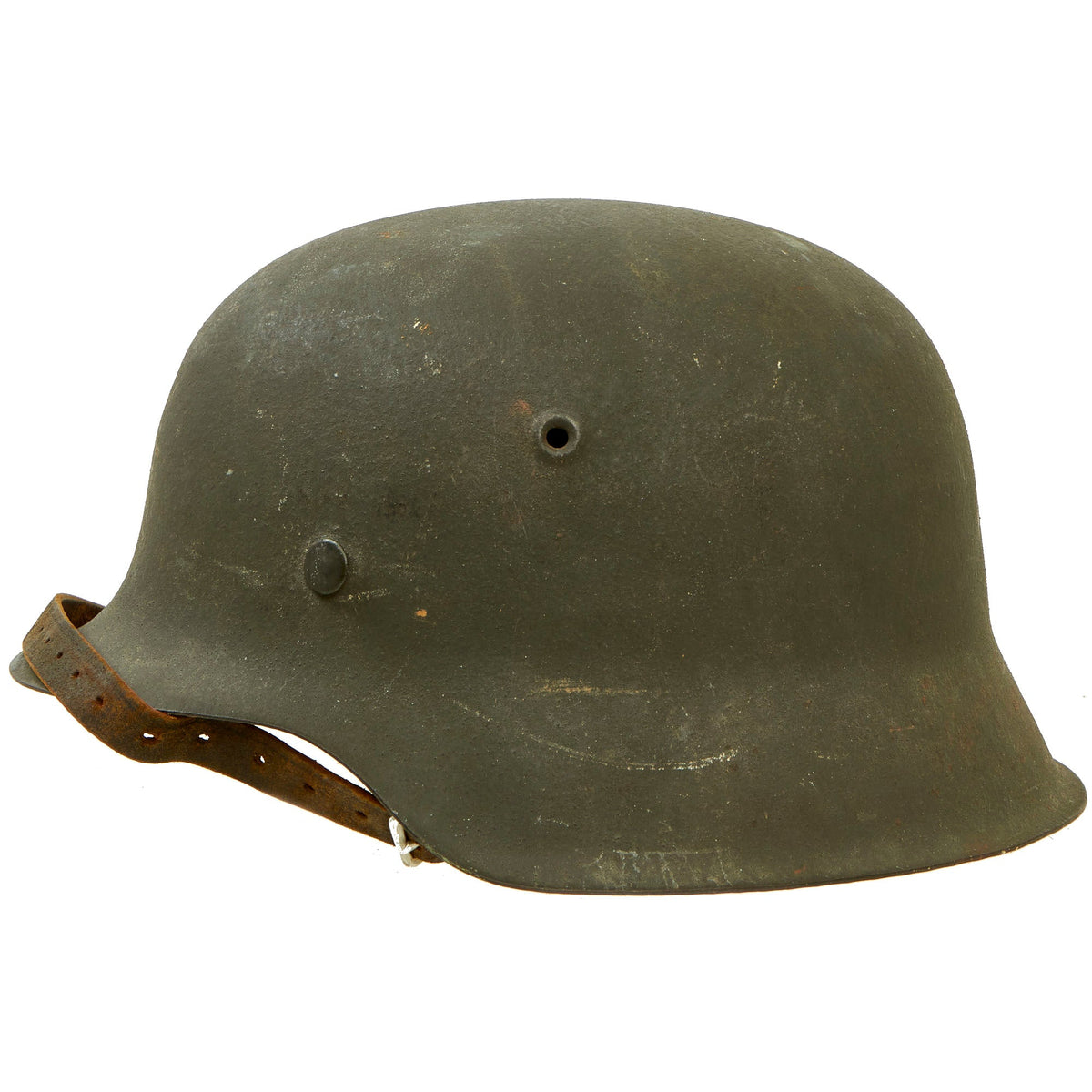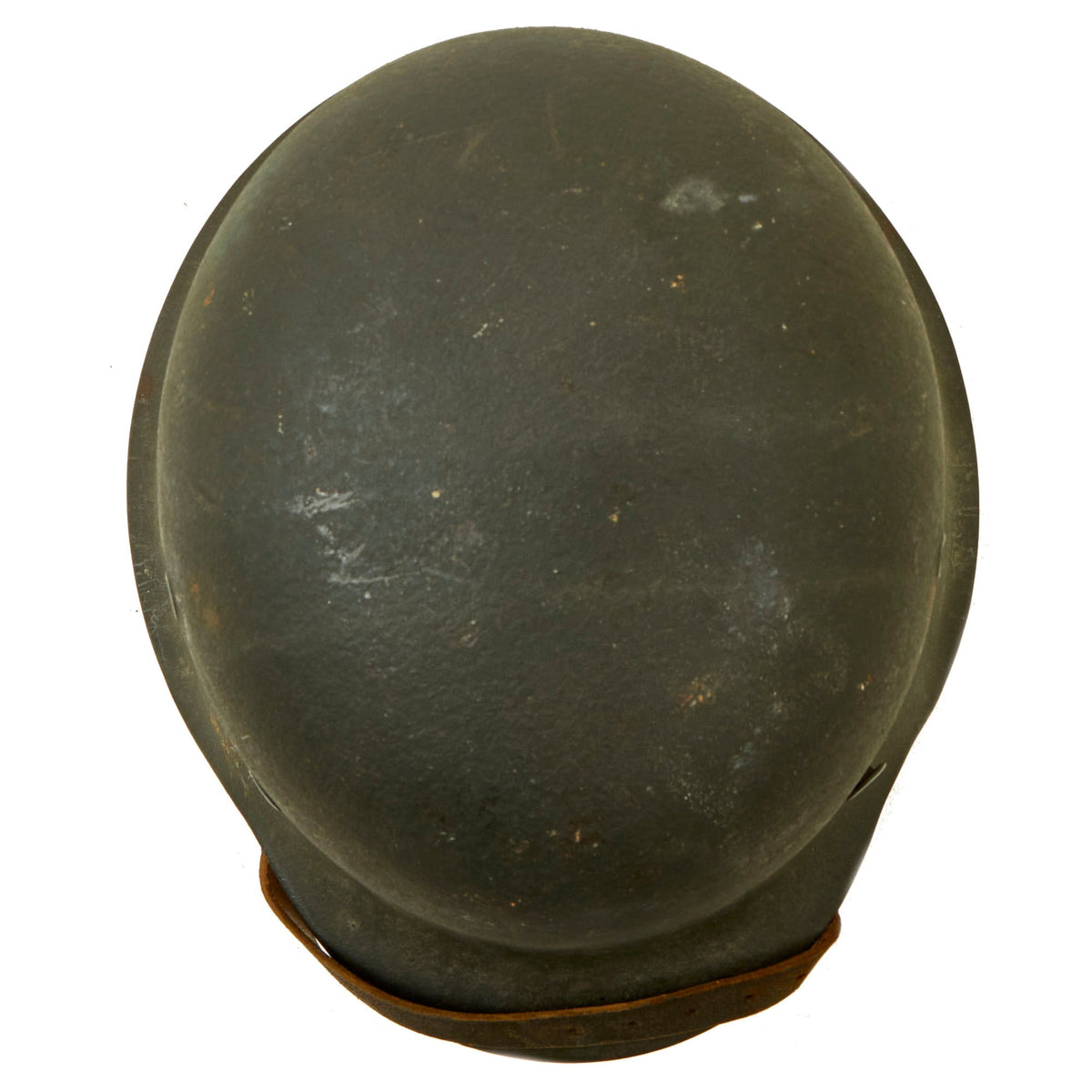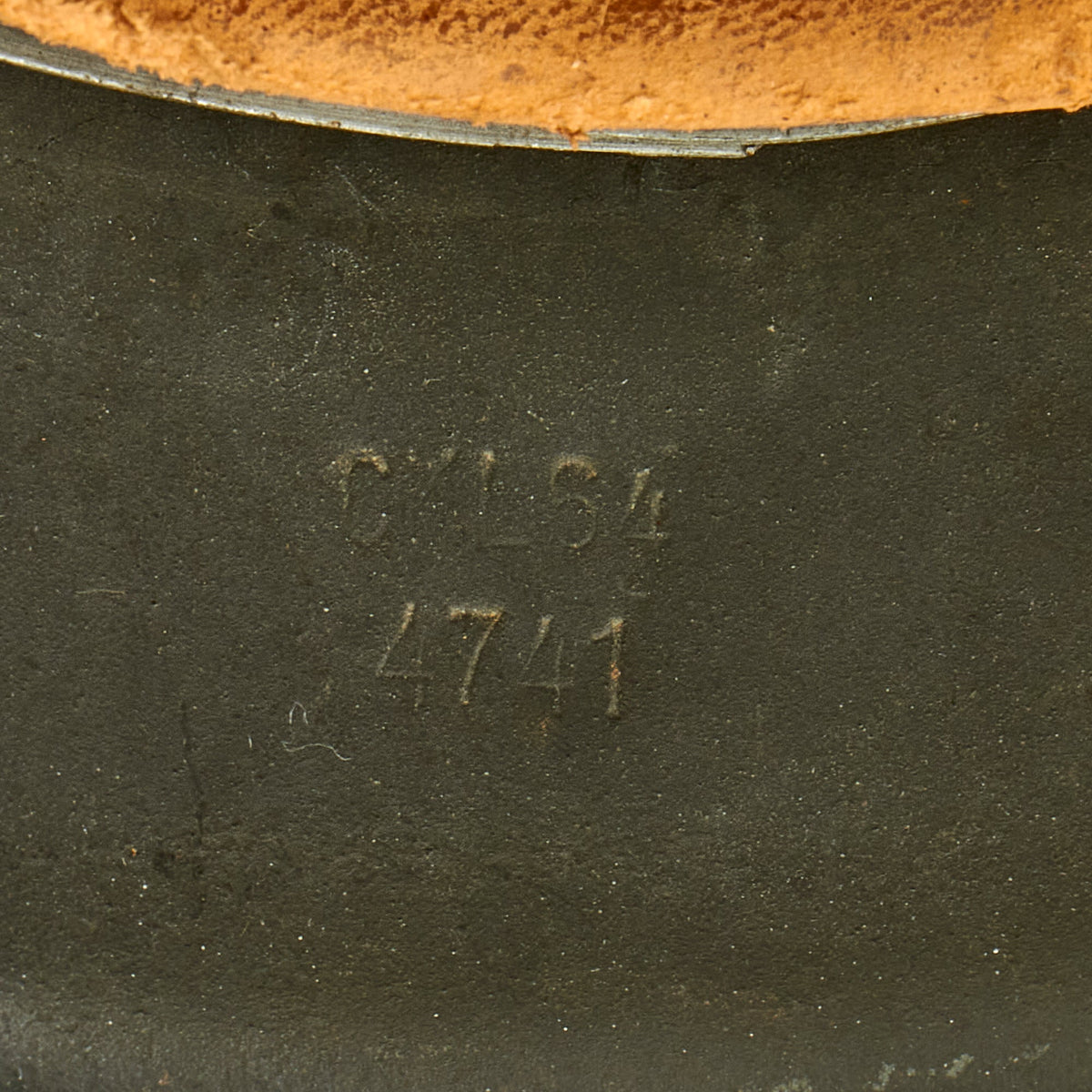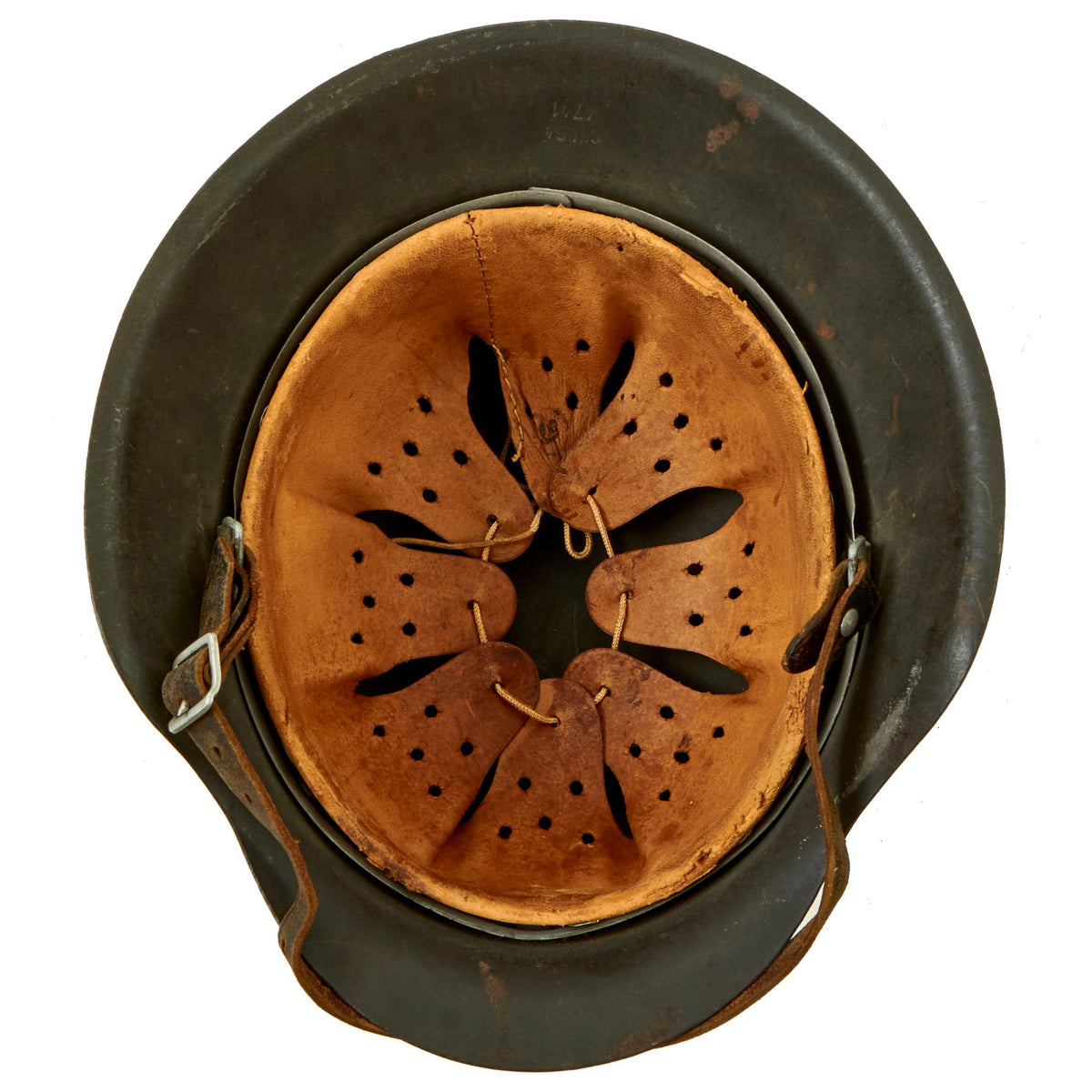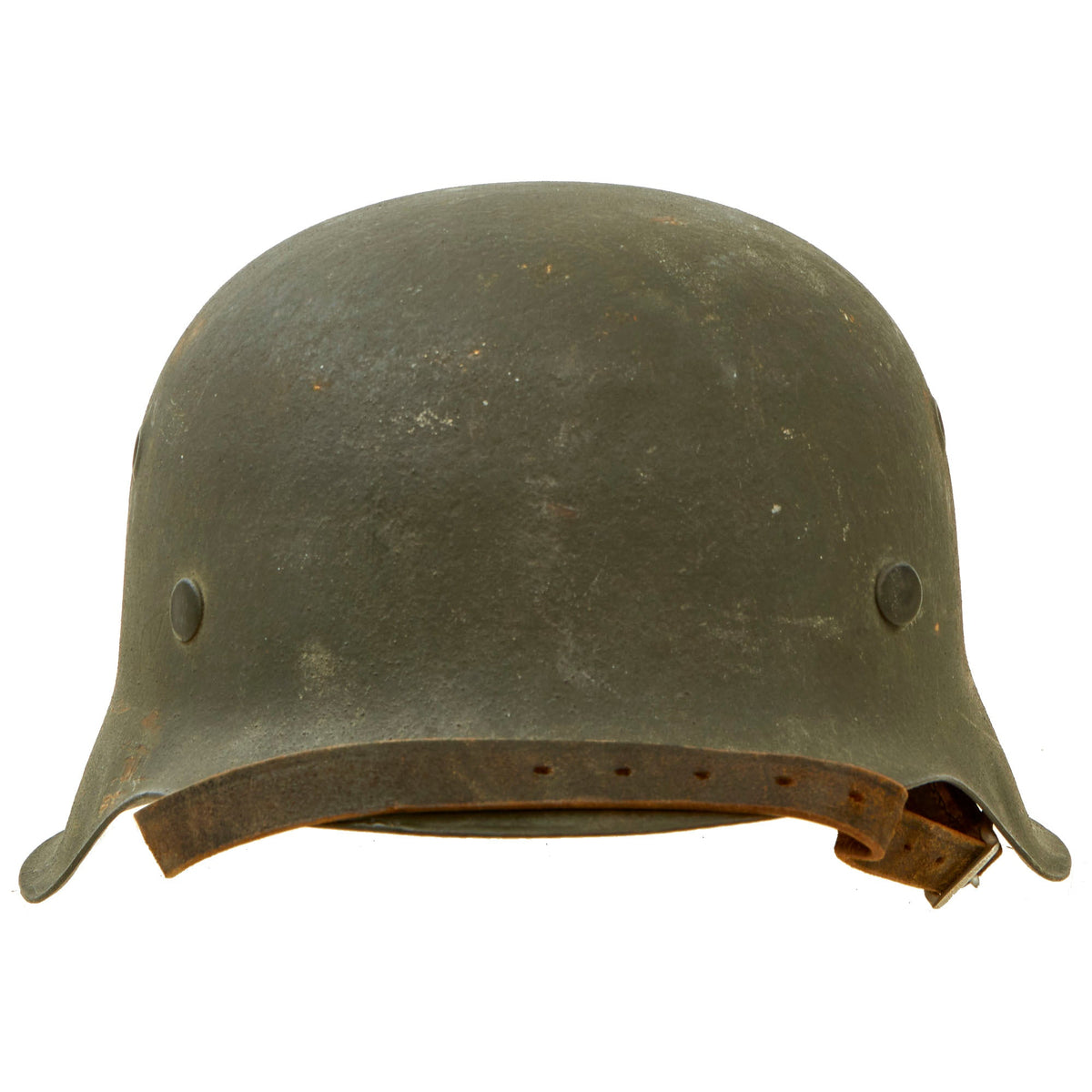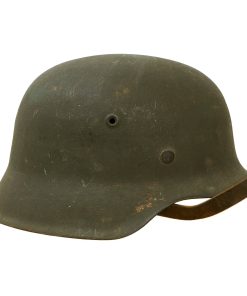Original Excellent German WWII M42 Army Heer “No Decal” Helmet with 57cm Liner, Chinstrap & Dome Stamp – CKL64 Original Items
$ 895,00 $ 223,75
Original Item: Only One Available. This is an excellent all original example of a German Model 42 Steel helmet, as issued to the Wehrmacht Heer (army). This stamped sheet steel construction helmet retains almost all of its original textured paint, showing very little wear of any kind. From what we can tell, this helmet saw very little use during the war, and most of the condition issues seem to come from storage. Really a great example of what M42 helmets looked like as they were original issued. There is no decal affixed to the shell, as late in the war they were often omitted due to supply and time constraints.
The shell is stamped with CKL 64 on the rear skirt above heat lot 4741, indicating that the Eisenhüttenwerke plant in Thale, Germany manufactured it. As the war progressed, Quist moved the size stamping to the rear to save production time, as did other makers. 64 Is a nice medium size that can accommodate liners from 56cm to 57cm or US 7 to 7 1/8. Size 64 shells are harder to find and are therefore more valuable to a collector. There is also a clear original DOME STAMP on the top of the shell, which we have unfortunately not been able to read accurately.
ET changed manufacturer code from ET to CKL, which occurred during final production of the M40 and initial production of the M42 models. M42s can be found with ET stamps and M40s with ckl stamps. The change to an ordnance code (ckl) was to protect the identity and location of the manufacturer from the Allies. Notice the lot number 4741. The lot number indicates the particular batch of sheet steel that was used when a quantity of helmet shells were produced. This was accomplished through several steps of press-forming or hot-stamping the shells. The lot number serves as a control number for the manufacturer and as an extra stamp of approval.
All three original liner retaining pins are present with all of their original paint retained. The interior of the helmet still has an original M31 leather liner, which is in very good condition, showing just a bit of flaking and wear around the rim. All eight fingers are fully intact, with the leather still soft and supple, and the top tie string intact. The later war issue galvanized steel liner band is marked on the left outer side with 64 n.A. / 57, indicating that the liner band is a size 57, intended for a 64 shell. There is also a clear 57 in a circle on the leather itself. The right side displays the full manufacture information, as well as a date:
0/0250/0022
1943
RBNr.
This is a known National Business designation, which has unfortunately not yet been identified. The chinstrap is an earlier war example or the standard “13 hole” chinstrap, with all aluminum hardware, and is marked on the end with:
H. EGER & LINDE
SELIGENTHAL/TH
1938
Most likely it was one put in storage at arsenal previously, and used again late in the war when this helmet was made.
Overall an excellent genuine German M42 helmet, complete with a liner and chinstrap, as well as a dome stamp with some great research potential! This is an item that will only continue to appreciate in value over time.
The first “modern” steel helmets were introduced by the French army in early 1915 and were shortly followed by the British army later that year. With plans on the drawing board, experimental helmets in the field, (“Gaede” helmet), and some captured French and British helmets the German army began tests for their own steel helmet at the Kummersdorf Proving Grounds in November, and in the field in December 1915. An acceptable pattern was developed and approved and production began at Eisen-und Hüttenwerke, AG Thale/Harz, (Iron and Foundry Works), in the spring of 1916.
These first modern M16 helmets evolved into the M18 helmets by the end of WWI. The M16 and M18 helmets remained in usage through-out the Weimar Reichswehr, (National Defence Force, Circa 1919-1933), era and on into the early years of the Third Reich until the development of the smaller, lighter M35 style helmet in June 1935.
In 1934 tests began on an improved Stahlhelm, whose design was a development of World War I models. The Eisenhüttenwerke company of Thale carried out prototype design and testing, with Dr. Friedrich Schwerd once again taking a hand.
The new helmet was pressed from sheets of molybdenum steel in several stages. The size of the flared visor and skirt was reduced, and the large projecting lugs for the obsolete armor shield were eliminated. The ventilator holes were retained, but were set in smaller hollow rivets mounted to the helmet’s shell. The edges of the shell were rolled over, creating a smooth edge along the helmet. Finally, a completely new leather suspension, or liner, was incorporated that greatly improved the helmet’s safety, adjustability, and comfort for each wearer. These improvements made the new M1935 helmet lighter, more compact, and more comfortable to wear than the previous designs.
The Army’s Supreme Command officially accepted the new helmet on June 25, 1935 and it was intended to replace all other helmets in service.
The M1935 design was slightly modified in 1940 to simplify its construction, the manufacturing process now incorporating more automated stamping methods. The principal change was to stamp the ventilator hole mounts directly onto the shell, rather than utilizing separate fittings. In other respects, the M1940 helmet was identical to the M1935. The Germans still referred to the M1940 as the M1935, while the M1940 designation was given by collectors.
In 1942, Due to wartime demands, the M-42 design was put into production because it was significantly quicker to manufacture. The rolled edge of the M-35 shell was eliminated, creating an unfinished edge along the rim. This edge flared out slightly, along the base of the skirt. The elimination of the rolled edge expedited the manufacturing process and reduced the amount of metal used in each helmet, without sacrificing protection.
Fast Shipping with Professional Packaging
Thanks to our longstanding association with UPS FedEx DHL, and other major international carriers, we are able to provide a range of shipping options. Our warehouse staff is expertly trained and will wrap your products according to our exact and precise specifications. Prior to shipping, your goods will be thoroughly examined and securely secured. We ship to thousands clients each day across multiple countries. This shows how we're dedicated to be the largest retailer on the internet. Warehouses and distribution centres can be located throughout Europe as well as the USA.
Note: Orders with more than one item will be assigned a processing date depending on the item.
Before shipping before shipping, we'll conduct a thorough inspection of the items you have ordered. Today, the majority of orders will be delivered within 48 hours. The delivery time will be between 3-7 days.
Returns
The stock is dynamic and we cannot completely manage it because multiple stakeholders are involved, including our factory and warehouse. So the actual stock may alter at any time. It's possible that you may not receive your order once the order has been made.
Our policy is valid for a period of 30 days. If you don't receive the product within 30 days, we are not able to issue a refund or an exchange.
You can only return an item if it is unused and in the same state as the day you received it. You must have the item in its original packaging.
Related products
Uncategorized
Uncategorized
Band of Brothers ORIGINAL GERMAN WWII Le. F.H. 18 10.5cm ARTILLERY PIECE Original Items
Uncategorized
Uncategorized
Uncategorized
Uncategorized
Uncategorized
Uncategorized
Uncategorized
Uncategorized
Uncategorized
Uncategorized
Uncategorized
Uncategorized
Uncategorized
Uncategorized

